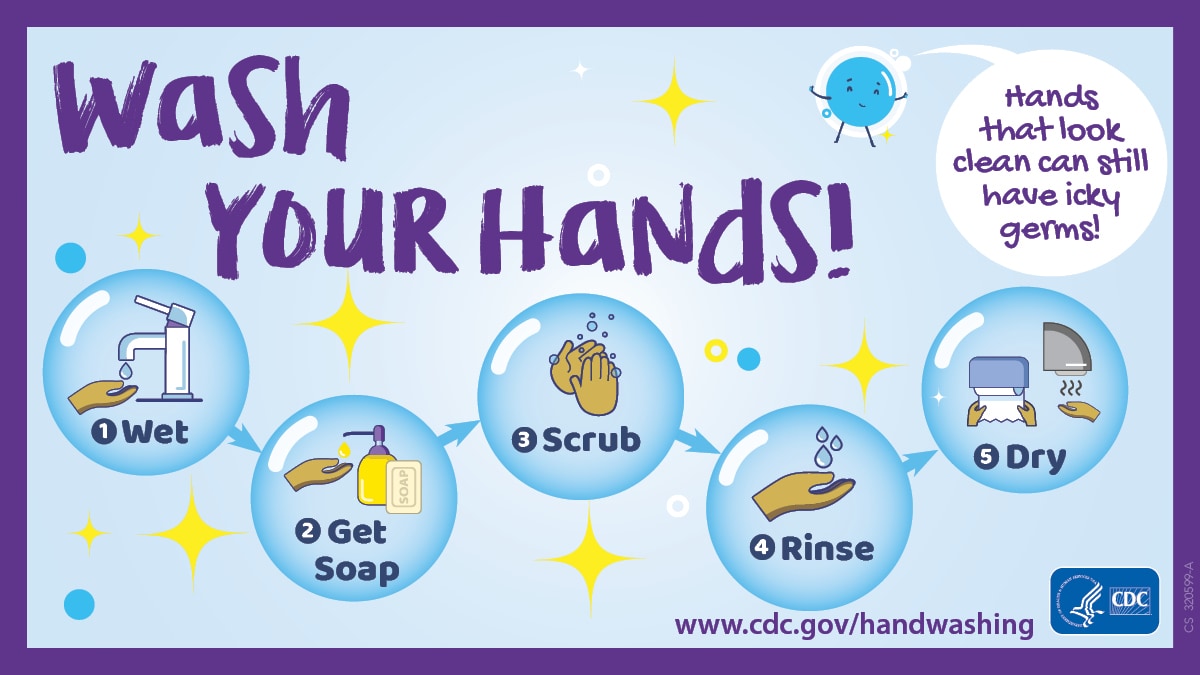- Home
- Government
- Health & Human Services
- Public Health
- Infection Prevention and Healthcare-Associated Infections (HAI)
- Infection Prevention Basics -Tips for Staying Healthy
Infection Prevention Basics -Tips for Staying Healthy
INFECTION PREVENTION BASICS – Tips for Staying Healthy
This page includes information of general practices that you can use to protect yourself and others from contagious infections that can be prevented. The practices have been proven through evidence-based science and are at the cornerstone of public health.
You can spread certain ‘germs,’ a term used for microscopic viruses and bacteria, by casually touching another person. You can also catch germs when touching contaminated surfaces and then touching your eyes, nose, or mouth. There are many things you can do to protect yourself and others.
Avoid Close Contact with People who are sick.
- If you are sick, limit contact with others as much as possible to keep from infecting them. Stay home from school or work to avoid close contact.
- Avoid touching your eyes, nose, and mouth. Microscopic germs enter the body this way.
- Cover a cough. Cover your mouth and nose with a tissue when you sneeze or cough, then dispose of it. If no tissue is handy, cough or sneeze into your elbow rather than into your hands. If you cough into your elbow, your hands will stay clean and your elbow cannot reach your face, so will prevent germs from further spreading through the hands either to you or to someone else.
Hand hygiene – Another significant way to reduce spread of infections is hand washing with soap and water and using an alcohol-based sanitizer. Good handwashing techniques includes using adequate amount of soap, rubbing hands together and creating lather and friction for 20 seconds, rinsing under warm running water, drying with paper towels or clean cloth. Handwashing removes germs from your hands that are not visible.

You should wash your hands:
- Before touching your eyes, nose, mouth, or face.
- When hands are visibly soiled.
- After using the washroom (includes changing diapers or assisting a person when using the toilet).
- After blowing your nose or after sneezing in your hands.
- Before and after eating, handling food, preparing meals, drinking, or smoking.
- After touching raw meat, raw eggs, poultry, or fish.
- After handling garbage or contact with contaminated surfaces such as garbage bins, or dirty cloths that have been used for cleaning.
- Visiting or caring for sick people.
- After wiping another person's nose or handling soiled tissues.
- Before preparing or taking medications.
- When caring for another person who is sick, including after contact with blood or body fluids such as vomit or saliva.
- Before and after treating a cut or wound.
- Before inserting and removing contact lenses.
- Handling pets, animals, or animal waste.
- After handling pet food or pet treats.
Use of Personal Protective Equipment (PPE) i.e., gloves, masks, eye protection.
Masking is the most common used PPE for the general public. During periods of increased respiratory infection activity in the community, a mask offers protection against droplets containing germs from spreading and containing respiratory secretions. Masks can be a surgical mask, a KN95 or NIOSH approved N95. N95 masks provide the highest protection for both the wearer and close contacts.
Cleaning and Disinfection
Viruses and bacteria can also spread by touching surfaces that harbor germs such as high touch surfaces including door handles, counter tops, desks, phones, keyboards, sinks. It is especially important if someone is sick at home, at school or in the workplace to clean high touch surfaces and kill and germs with an EPA approved disinfectant. EPA approved cleaners can be selected to kill specific pathogens or also a general cleaner. Household cleaners may or may not kill pathogens. Learn more about EPA approved cleaners here. Use cleaners according to directions and safety protocols.
Contact Us
-
20111 Cedar Road N.
Sonora, CA 95370
Ph: 209-533-7401
800-585-6606 (toll free)
Fax: 209-533-7406
Hours
Monday - Friday 8 a.m. - 5 p.m.
- Tuolumne County Opioid Handout 2025
- Community Resource Guide 2023
- Public Health Referral Form
- Tuolumne County Community Improvement Plan 2024
- Tuolumne County Public Health Community Health Needs Assessment Supplement 2023
- Wildfire Smoke Health Tips
- 2024 Suicide Data Report
- Influenza Vaccinate or Mask Order
